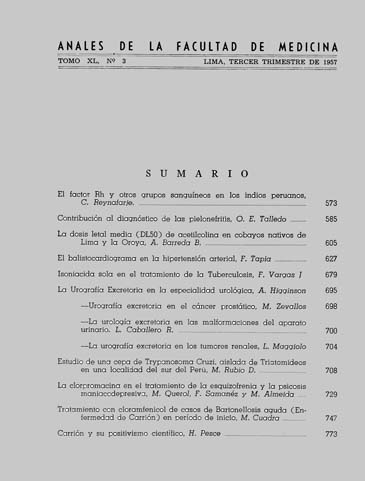Contribution to the diagnosis of pyelonephritis
DOI:
https://doi.org/10.15381/anales.v40i3.10775Abstract
35 Control: A total of 100 subjects distributed as follows 21 with pyelonephritis was studied as a single diagnosis; 26 with pyelonephritis associated with other processes; TBC 8 kidney and pyelonephritis probable; and 10 with various diagnoses. In finding all the "cells of pyelonephritis" was performed and in most qualitative urine culture done. In 11 no histopathological report. In the control subjects, the finding was negative cells in all. Urine cultures were negative in 2. In subjects with pyelonephritis as a single diagnosis, the cells were found in 95.4%. Urine culture was positive in 94.1% of cases studied. In the group of pyelonephritis associated with other processes, there were cells in the presence of 88.4% and the urine culture was positive in 91.3% of the cases studied. In TBC kidney and pyelonephritis likely cells was found in 87.5%; and 100% of urine was positive. The "diverse" group in any cell was found in 2 of them the urine culture was positive. Of the 45 positive urine cultures, 50% were Escherichia coli; Paracolon gender 27.2%; 15.1% and Staphylococcus Protsus gender; Klebsiella 9.09%; Streptococcus 6.06%; 3.03% Alcalígenos Diphtheroids faecalis and Bacillus and Neisseria 1.01%.Downloads
Published
1957-09-16
Issue
Section
Trabajos originales
License
Copyright (c) 1957 Oscar E. Talledo C.

This work is licensed under a Creative Commons Attribution-NonCommercial-ShareAlike 4.0 International License.
Those authors who have publications with this magazine accept the following terms:
- Authors will retain their copyrights and guarantee the journal the right of first publication of their work, which will be simultaneously subject to Creative Commons Attribution License that allows third parties to share the work as long as its author and its first publication this magazine are indicated.
- Authors may adopt other non-exclusive licensing agreements for the distribution of the version of the published work (eg, deposit it in an institutional electronic file or publish it in a monographic volume) provided that the initial publication in this magazine is indicated.
- Authors are allowed and recommended to disseminate their work over the Internet (eg: in institutional telematic archives or on their website) before and during the submission process, which It can produce interesting exchanges and increase quotes from the published work. (See El efecto del acceso abierto ).
How to Cite
1.
Talledo C. OE. Contribution to the diagnosis of pyelonephritis. An Fac med [Internet]. 1957 Sep. 16 [cited 2024 Aug. 16];40(3):585-604. Available from: https://revistasinvestigacion.unmsm.edu.pe/index.php/anales/article/view/10775















